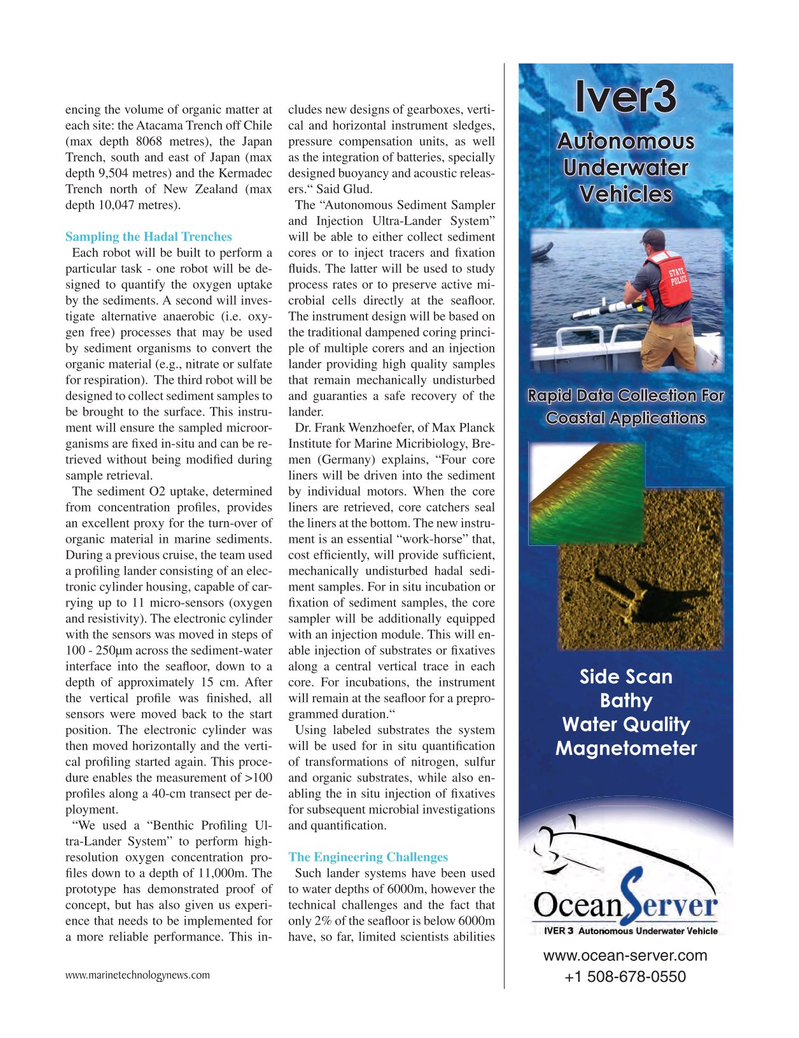
Page 37: of Marine Technology Magazine (September 2015)
Ocean Observation: Gliders, Buoys & Sub-Surface Networks
Read this page in Pdf, Flash or Html5 edition of September 2015 Marine Technology Magazine
Iver3 encing the volume of organic matter at cludes new designs of gearboxes, verti- each site: the Atacama Trench off Chile cal and horizontal instrument sledges, (max depth 8068 metres), the Japan pressure compensation units, as well
Autonomous
Trench, south and east of Japan (max as the integration of batteries, specially
Underwater depth 9,504 metres) and the Kermadec designed buoyancy and acoustic releas-
Trench north of New Zealand (max ers.“ Said Glud.
Vehicles depth 10,047 metres). The “Autonomous Sediment Sampler and Injection Ultra-Lander System”
Sampling the Hadal Trenches will be able to either collect sediment
Each robot will be built to perform a cores or to inject tracers and ? xation particular task - one robot will be de- ? uids. The latter will be used to study signed to quantify the oxygen uptake process rates or to preserve active mi- by the sediments. A second will inves- crobial cells directly at the sea? oor. tigate alternative anaerobic (i.e. oxy- The instrument design will be based on gen free) processes that may be used the traditional dampened coring princi- by sediment organisms to convert the ple of multiple corers and an injection organic material (e.g., nitrate or sulfate lander providing high quality samples for respiration). The third robot will be that remain mechanically undisturbed designed to collect sediment samples to and guaranties a safe recovery of the
Rapid Data Collection For be brought to the surface. This instru- lander.
Coastal Applications ment will ensure the sampled microor- Dr. Frank Wenzhoefer, of Max Planck ganisms are ? xed in-situ and can be re- Institute for Marine Micribiology, Bre- trieved without being modi? ed during men (Germany) explains, “Four core sample retrieval. liners will be driven into the sediment
The sediment O2 uptake, determined by individual motors. When the core from concentration pro? les, provides liners are retrieved, core catchers seal an excellent proxy for the turn-over of the liners at the bottom. The new instru- organic material in marine sediments. ment is an essential “work-horse” that,
During a previous cruise, the team used cost ef? ciently, will provide suf? cient, a pro? ling lander consisting of an elec- mechanically undisturbed hadal sedi- tronic cylinder housing, capable of car- ment samples. For in situ incubation or rying up to 11 micro-sensors (oxygen ? xation of sediment samples, the core and resistivity). The electronic cylinder sampler will be additionally equipped with the sensors was moved in steps of with an injection module. This will en- 100 - 250µm across the sediment-water able injection of substrates or ? xatives interface into the sea? oor, down to a along a central vertical trace in each
Side Scan depth of approximately 15 cm. After core. For incubations, the instrument the vertical pro? le was ? nished, all will remain at the sea? oor for a prepro-
Bathy sensors were moved back to the start grammed duration.“
Water Quality position. The electronic cylinder was Using labeled substrates the system then moved horizontally and the verti- will be used for in situ quanti? cation
Magnetometer cal pro? ling started again. This proce- of transformations of nitrogen, sulfur dure enables the measurement of >100 and organic substrates, while also en- pro? les along a 40-cm transect per de- abling the in situ injection of ? xatives ployment. for subsequent microbial investigations “We used a “Benthic Pro? ling Ul- and quanti? cation.
tra-Lander System” to perform high- resolution oxygen concentration pro- The Engineering Challenges ? les down to a depth of 11,000m. The Such lander systems have been used prototype has demonstrated proof of to water depths of 6000m, however the concept, but has also given us experi- technical challenges and the fact that ence that needs to be implemented for only 2% of the sea? oor is below 6000m a more reliable performance. This in- have, so far, limited scientists abilities www.ocean-server.com www.marinetechnologynews.com +1 508-678-0550
MTR #7 (34-49).indd 37 MTR #7 (34-49).indd 37 9/2/2015 2:07:37 PM9/2/2015 2:07:37 PM

 36
36

 38
38
